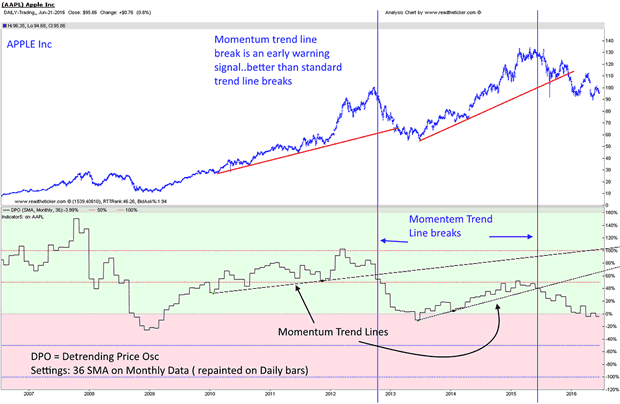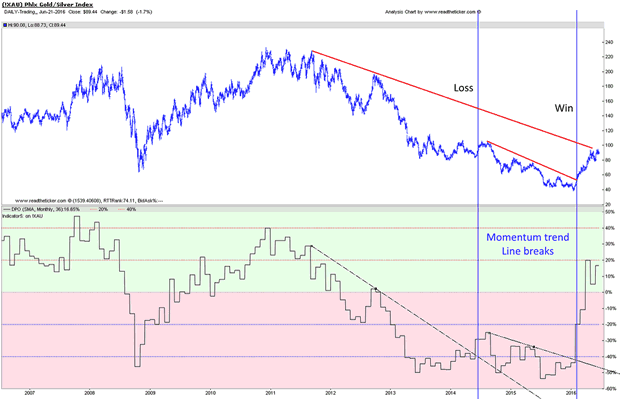Stocks & Equities
A change in long term momentum can forecast that the trend is near the end!
Energy is required to move a stock, and YES it does run out! Energy (demand or supply) can be measured by standard momentum tools (Detrending Price Osc), and keeping an eye on the longer term momentum trend is vital to keeping your profits.
Wyckoff traders must monitor long term momentum to check accumulation and distribution patterns on there charts. Major price weakness will be forecast by major momentum weakness.
Below are two major trend changes.
Apple Inc

Metal stocks

Investing Quote…
“Success in trading means excess of profits over losses. If anyone tells you they can almost be invariably successful, put him down as trying to impose on your credulity.” ~ Richard D Wyckoff
“The stock market is filled with individuals who know the price of everything, but the value of nothing.” ~ Philip Fisher
“In the short run, the market is a voting machine, but in the long run it is a weighing machine.” ~ Benjamin Graham
“Successful speculation requires staying on top of changes in industries and companies that either create new industries or improve on existing industries. The majority of your profits will come from these two … The shrewdest traders throughout history all adapted the skill of reactionary change, as the market constantly presents new and different opportunities.” ~ Bernard Baruch
“Markets are constantly in a state of uncertainty and flux and money is made by discounting the obvious and betting on the unexpected.” ~ George Soros
related:

 Tomorrow, one of the most important financial decisions of the past 20 years will be put to a referendum in Britain. Should Britain remain a part of the European Union, or should it leave?
Tomorrow, one of the most important financial decisions of the past 20 years will be put to a referendum in Britain. Should Britain remain a part of the European Union, or should it leave?
I won’t venture to guess on the results. It would be a toss of the coin. Or, it would be a rigged referendum, thrown into disarray by the assassination of liberal British lawmaker, Jo Cox, last week.
But I do know this: If British citizens are smart enough … if they care enough about their country’s rich heritage and sovereignty … they should vote to leave the EU as fast as possible.
You see, in addition to all the problems with the euro that the European Union has — it has other problems with member countries like Britain, which joined but did not accept the euro as its currency.
Thanks to Margaret Thatcher, who, with her wisdom beyond the ages, knew that the European Union was really a political union in disguise, an attempt to unite Europe under the guise of no more wars, even trade wars. Of uniform labor laws and central bank policies. Of uniform interest rates, free flow of labor and single currency.
But Thatcher saw through it all and saw it plainly for what it was: A power grab by the elite to have a majority of European countries give up their sovereignty, mainly to the strongest economy in the region, Germany …
And from there, work toward an authoritarian society where the elite of Germany, France and Brussels called all the shots.
Thatcher was 100% right. So she — unwillingly — allowed England to join the EU, but only on the condition that Britain be allowed to own its currency, the pound. A country’s currency is its pride of sovereignty — almost synonymous with its national flag — and no way was Thatcher going to give that up.
So what happened next? Something Thatcher didn’t foresee. As punishment for not taking on the euro, the European Union began to issue one burdensome regulation after another, attempting to stifle the economic growth of those countries that joined the union, but not the currency.
And in the years since, each and every one of those countries — the U.K., Denmark and Sweden — has largely seen its economic performance lag well behind not just the West or the Far East, but also behind the euro countries.
We’ll find out soon enough — tomorrow. As I said at the outset, it would be far better for the U.K. to leave, to escape the burdensome regulations of the EU, and to take back its sovereignty.
The same, by the way, can be said of every country in the EU. It is a failed experiment that was doomed from the get-go, and the longer Brussels tries to hold it together, the greater the backfire will become. And in the end, instead of uniting Europe, it will tear apart.
What about the immediate consequences of tomorrow’s decision? Here, too, one can only guess wildly; it’s such an important decision.
But I have an edge with my AI models, that give me a fairly reliable sneak peek at the future market movements. And from those sneak peeks, I can tell you what I think will happen.
First, Britain will vote to stay in the European Union. But don’t be surprised if you hear accusations of rigged voting as early as tomorrow.
Second, assuming Britain does vote to stay in, you should see another rip-roaring move to the upside in European and U.S. equities, just like we saw on Monday. Why? It would merely be a relief rally, euphoria over having everything staying the same rather than confronting change, which no one likes.
Third, expect the British pound to fall sharply against the euro, debasing the pound to give Britain a currency competitive trade edge going forward.
Fourth, expect commodities, mainly gold and silver, to plunge. There has been an enormous amount of gold and silver buying over the past two months or so as hedges against a calamity in the EU and Britain leaving. But if Britain doesn’t leave, those gold and silver hedges will get dumped before you can bat an eyelash. Same for mining stocks.
Fifth, the U.S. dollar will soar. Caught in a months-long sideways trading range, no-Brexit will send the dollar soaring, smashing other dollar-sensitive commodities along the way, everything from oil to soybeans.
It’s going to be a wild trading day today … vote day tomorrow … and even Friday. Not only is the decision a huge one, but most major brokerage firms are upping margin requirements as much as three-times over to cover the anticipated volatility.
Best wishes, as always …
Larry

 Ed Note: the results will be approximately 11pm PST thursday night.
Ed Note: the results will be approximately 11pm PST thursday night.
Betfair says £40.5 million has so far been chanced on the result of the referendum to make it the biggest political betting event in British history.
Bookmakers said the frenzy of excitement over the looming vote has prompted some people to place bets for the first time. Which means it may be of more than passing significance that bookies are now saying they are very confident of a Remain vote and may even make the In camp still stronger favourites in the final run-up to the vote.
related:

Quotable
“I have experienced failure as a politician and for that very reason, I am ready to give everything for Japan.”
Shinzo Abe
Commentary & Analysis
Talk of yen intervention makes sense…but first Brexit to deal with

Japanese industry is worried the yen strength will hurt its overseas sales.
The yen’s recent approach to ¥100 against the dollar has provoked speculation that the Ministry of Finance may be poised to intervene for the first time since 2011.
“We think the time to act has already arrived. It’s already ¥104, ¥105 to the dollar. It was ¥118 in January. From ¥118 to ¥104 — that’s ¥15 in six months,” said Mr [Sadayuki] Sakakibara [chairman of the powerful Keidanren business lobby].
“That is not orderly. Extremely disorderly is all you can call it. To keep it stable in a reasonable range then certainly the Ministry of Finance should act.”
Financial Times , 20 June 2016
It used to be no matter how strong the value of the Japanese yen, the country’s trade balance remained quite high; even despite attempts to punish Japan a la the the Plaza Accord [G-5 countries intervening back in September of 1985 to weaken the dollar against both the Japanese yen and Germany mark].
In the chart below I have overlaid the USD/JPY on top of the monthly Japanese Trade Balance going back to 1982. The yen weakened from a whopping 277 to the dollar during 1982 to just 84 yen per dollar by 1995. Yet, as said, Japan’s trade balance remained strong.
In the chart below, I have shifted the USD/JPY by 20 months into the future. As you can see, the correlation between the value of the yen and trade is seen more clearly.

The game changer of course was the credit crunch, which altered the supply and demand dynamics in the global economy in a very big way. As the yen strengthened on haven flow from around USD/JPY 123 to USD/JPY 77 in the midst of the credit crunch, Japan’s trade balance started consistently deteriorating.
Thus it was the beginning of the three-arrow strategy from Japanese PM Abe—the first arrow was intended to weaken the yen. And as you can see in the chart above (and below) it worked.

So, based on the correlation seen above, it seems in this new abnormal world where demand is not quite stagnant, but weak at best, Japanese industry seems right be worried. It suggests calls for intervention may soon be acted upon.
However, I suspect Japan is keeping powder dry till after the Brexit vote. Because if the Brits decided they want sovereignty back, the yen likely rally sharply again on haven flow, similar to what it did during the credit crunch, but in mini-fashion.
Next stop on haven flow to the yen is likely the 100 target many have discussed. It represents a 50% retracement from the low going back to November 2015—when the three-arrow strategy got underway. But after a move to 100, it would seem the potential pressure would be too much for Japan’s government—they would likely decide to step in with barrels blazing.
USD/JPY Monthly:

If the “remain” block wins the Brexit vote, either $-yen rallies (yen weakens) of its own accord and/or the government helps it along; that seems the consensus bet. But Mr. Market is likely to be particularly tricky in here so any confidence in the consensus should remain limited.
Jack Crooks
President, Black Swan Capital
also, the latest from Martin Armstrong: Central Banks Made Govt Debt the Riskiest Debt of All Time

Another down day for the Dow on Friday left it in the red for the week.
Barron’s, in a lather, says it is facing the “Two Horsemen of the Apocalypse.”
Huh?
Supposedly, the so-called Brexit – the vote in Britain this Thursday on whether to leave or remain in the European Union (EU) – and uncertainty over where the Fed will take U.S. interest rates are cutting down stocks faster than a Z-turn mower.
Doomsday Device
But Brexit is a side show.
As our contacts in London explained in last week’s issue of Bonner & Partners Inner Circle, Britain will do just fine outside of the EU. It will even thrive. [Inner Circle members can catch up here.]
 As for the Fed’s fumbling, it is a consequence, not a cause, of falling stock prices.
As for the Fed’s fumbling, it is a consequence, not a cause, of falling stock prices.
The real threat to this market is more basic… more dangerous… and completely unavoidable. It is a “doomsday device” – hidden in plain view – in the feds’ fiat money system.
It took us a long time to understand how this works. For many years, we referred to the Fed’s EZ money policies as “printing money.” Finally, we realized that this metaphoric description of the Fed’s role probably hides more than it reveals.
The Fed is not printing money. If it were printing money, we’d have more money around… and higher consumer prices.
Instead, when the feds went to a “paper” money system in 1971, they did it very cleverly.
Yes, their new system is totally fraudulent and absolutely ruinous – just like an old fashioned money-printing scheme. But the fraud takes much longer to uncover… and the ruin is only obvious at the end.
It is a “bezzle”… where you only become aware that you’ve been had when it blows up.
Unlimited Credit
Here’s the deal…
Instead of printing money itself, the Fed allows banks to create an almost unlimited amount of credit (providing they meet certain capital requirements).
Contrary to popular belief, banks don’t act as “warehouses” – taking in deposits and then lending them out again. Instead, banks create new deposits (aka money) when they make a loan.
All it takes is a few strokes on a keyboard, and account balances – along with the money supply – go up.
At first, this new credit-money acts much like printing-press money: It gives people money to spend that nobody ever earned. Everybody is happy.
But if you keep on creating more and more paper money, the fraud is soon obvious. Prices rise. People realize that they have no more purchasing power than they had before.
In the meantime, businesses and consumers have all made bad decisions, based on the apparent increase in “demand.”
After a while, all those mistakes have to be flushed out… in a recession or a depression.
Problem Postponed
By setting up this credit-money system, on the other hand, the feds avoided that problem… or at least, postponed it.
Between 1980 and 2016, for example, Americans spent $32 trillion in net, excess credit. That’s credit (and debt) above and beyond the historic relationship between GDP and debt.
That, too, would have increased consumer prices dramatically, but the Japanese… and then the Chinese… were busily making things much more cheaply.
This offset consumer price increases. And more important, much of the increase in credit-money went directly into Wall Street, instead of the Main Street, economy.
In a credit-money system, the sectors of the economy that are most creditworthy get most of the new money.
Who’s most creditworthy?
The rich. Big business. Government.
Prices soared, all right. But they were the kinds of prices people wanted to go up. Houses… businesses… commercial real estate… collectibles – talk about inflation; these things went through the roof.
Everything that can be financialized – priced and traded – became incredibly expensive. But the price of labor went nowhere.
The Rich Get Richer
Almost unbelievably, according to the Pew Research Center, today’s average hourly wage has roughly the same buying power as it did in 1973 – more than 40 years ago.
The system hasn’t done much for the common man, but it has helped the rich get richer. And now we know that the Deep State controls the U.S. government (and indirectly, the Fed and the financial system). So nobody really cares about the voters anyway.
What a system!
The banks are allowed to create money. They lend it to consumers until the household sector can’t take anymore. (This is what happened in 2008). Then they lend to corporations and the government.
One by one, each sector takes on too much debt and ceases to be creditworthy. Finally, only government can borrow… because it is the only sector that can print money!
We’re approaching that already in Japan, where the central bank buys about 100% of new Japanese government debt issuance.
Recession Warning
If the feds had handed out paper money, prices would have gone up. But even in a recession, or a debt deflation, the cash would still be there. Printing-press money raises prices, permanently.
But a credit-money system is very different. Every new dollar that comes into the system is also another dollar of debt.
Now, American consumers, businesses, and government all drag behind them about $60 trillion in debt. It slows them down. It depresses economic growth. And most important, it is subject to the credit cycle… and to the “doomsday device” built into system.
A recession is coming in the U.S.
If it hasn’t already begun, it will probably set in within six months. When that happens, stock prices will fall.
This will have a similar effect as the 2008 crisis… when houses plunged. Ultimately, a company’s earnings potential and stock market equity provide the collateral for its debt. When the stock market falls, lenders disappear.
Then, the debt market tightens and the doomsday device explodes.
Debt is just the flip side of credit. As debt goes bad, credit disappears. And then the system that created so much credit-money will go into reverse, destroying the nation’s money supply.
The money supply (actually, the supply of ready credit) will shrink – suddenly and dramatically. And what should have been a minor, routine pullback in the economy will become a catastrophic panic.
Don’t go away!
Regards,
Bill
related: The Fed Just Lost All Credibility












